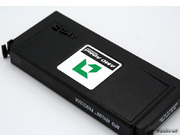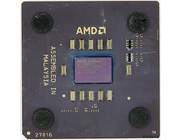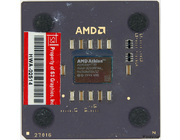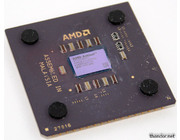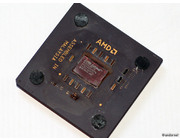| A powerfull and popular creation by AMD which was launched on June 5, 2000. It saw daylight in slot A and socket A packages and it's final version ran up to 1400MHz. The 'Thunderbird' surpassed the predecessor by implementing on-die full speed L2-cache, which is a lot faster than off-die half speed (or even one-third) L2-cache. Intel did the same trick with the Pentium III, which also gained a speedbump. Besides implementing full-speed cache, AMD also used an exclusive cache design. This combines L1 and L2-cache, of which L1-cache is the fastest. The Athlon has a big L1-cache which is good for performance. |  |
This CPU is identical to this Athlon 1400 except that is has been made 3 weeks earlier and that someone removed the four pads/cushions that support the heatsink. > Read more
A regular AMD Athlon 'Thunderbird' running at 1100MHz using a 100MHz FSB. AMD also made Athlon's up to 1400MHz that still used the 100MHz FSB to be able to offer CPU's that could run on older motherboards that didn't support a 133MHz (DDR266) FSB. However, at these higher speeds the 133MHz FSB version would've been favorable since it has a faster I/O throughput and memory access. > Read more
With it's 1300MHz clock and 100MHz (DDR200) FSB this is the smaller brother of the Athlon 1400C.
Just like with the 1400MHz model this was considered a 'hot-running' CPU. Back in it's day it's thermal properties we're highly debated in forms of fanboyism. A lot of the CPU coolers back then we're simple heatsinks with too small and too loud fans on them. If you equipped your Athlon with a bigger heatsink and a bigger, but slower running fan alongside with a slight breeze of airflow you wouldn't experience heat problems ![]() . > Read more
. > Read more
Introduced on June 5, 2000 along with all S462 Athlon models between 600MHz and 1000MHz. You would pay a high premium for owning the fastest CPU back in 2000 if you bought this CPU. It's 'new price' was $990! If you opted for the 900MHz model you would just pay $589. Almost 50% saved ![]() .
.
Notice that this Athlon 1000 is often named Athlon 1000B. This is due the fact that the Athlon 1000 is available in different configurations:
1. Athlon 1000: the original slot A version.
2. Athlon 1000B: the first version on socket A with 100MHz (DDR200) FSB.
3. Athlon 1000C: socket A version with 133MHz (DDR266) FSB. > Read more
A regular Athlon 900 on a 100MHz (DDR200) bus but, according to the sticker, used to be property of S3 Graphics. > Read more
A proper 800MHz part; made in Q3 of the year 2000 and made for socket A. Athlons from early 2000 often use the much bigger slot A connector.
In it's day this 800MHz piece was a normal 'good performer'. Not the fastest part available, but by far not a budget part. Especially compared to the more expensive Pentium III; the socket A motherboards matured, got cheaper and along with an Athlon 'Thunderbird' the Athlon was clearly the better choice. > Read more
A strong performer. This is the B-variant which uses a 100MHz (DDR200) FSB. The C-variant uses the faster 133MHz (DDR266) bus but still runs at 1200MHz.
The 1200MHz model is solid and reliable while staying within cooling proportions. Models like the 1333 and 1400 needed better cooling and stretched the motherboards' VRM's and the chip itself more. They still ran great; but needed better components. Back in the days a lot of people said that the AMD chips ran too hot but they often changed mind when Intel's Prescott came out. > Read more
The fastest Athlon 'Thunderbird' out there. At the time this was considered a real hot CPU in terms of power consumption/heat output. People ofted blamed AMD for having hot running CPU's but in the years after the Athlon 1400 many new CPU's were released by both AMD and Intel which ran hotter.
CPU's like the Athlon64 6000+ and Pentium 4 'Prescott' generated a lot more heat than this 1400MHz Athlon 'Thunderbird'. I guess it just needed time for people to get used to excessive heat output. Of course thermal solutions got better and more silent as time went by, so many people didn't notice that their PC was power hungry. In the time of the CPU the first high-end CPU coolers where deafening loud, glad that's over!
Also notice the 'die' on the photo. It's a bit chipped but the CPU still works ![]() . > Read more
. > Read more
The 1333MHz Athlon is the second fastest Athlon 'Thunderbird' CPU one can get. Back then it offered enough power leaving the Pentium 4 nowhere in many applications, especially with price/performance ratio in mind.
Back in the day the high clocked Athlon's ran quite hot although many newer CPU's have been released to date that use more power. The combination of "that such power demands were new back in the day" and that the Athlon also used quite a lot of power when running idle made the known for it to run very hot. Later when cooling solutions improved in the form of bigger (copper) heatsinks with bigger, yet slower running fans you could run an Athlon system that was whispering quiet. Unfortunately a lot of systems got equipped with a 5000RPM running little fan installed... ! > Read more
Technically this slot A model is the same as this socket A (462) Athlon 850. Both have the 'Thunderbird' core with 256KB on-die full speed L2 cache. I did not benchmark the Slot A version of the 850MHz 'Thunderbird'. It should perform identical except for differences in motherboard chipsets.
The 850MHz Slot A Athlon exists in two versions. One has the Thunderbird core, the other a Pluto core. The latter is like this Athlon 500 with 512KB off-die L2 cache. The 500MHz model has L2 cache on 1/2 of the core frequency and the 850MHz model has 1/3.
Please check motherboard compatibility if you want to run 'Thunderbird' Slot A CPU's. For example the Gigabyte GA-VX7 doesn't support this CPU. If I remember correctly support for 'Thunderbird' CPU's is usually better on Irongate chipsets rather than VIA KX133 chipsets. > Read more
A normal AMD Athlon CPU, one you could buy in the stores in the end of the millennium year.
The AMD Athlon is known to run quite hot. They did compared to the Pentium III. The Pentium 4 'Willamette' is much cooler in idle modus but in stressed they consume a lot of power, too. Fact that the Athlon runs hot is true. The fact that they can handle much heat is also true. It's not uncommon that an AMD Athlon can run at 70C or higher with ease. All that is needed is a good heat transfer between the 'die' of de CPU and the heatsink.
Look at the picture to see a pretty much banged up CPU. I suspect that the previous owner used to run this CPU in quite a hot environment. Compare the discoloration with this Athlon 1000! Also note that the 'die' of this Athlon 850 is not perfect anymore. Yet it works fine.
People often refer to 'core' when they see the tiny chip on the ceramic packaging of the Athlon. I refer to 'die' as the thing you see is a 'die', the actual 'core' is inside this 'die'. The 'die' is used to protect the 'core' and to transfer heat from the 'core' to the surface of the 'die' on which a heatsink can be installed. Damages to the 'die' doesn't mean the 'core' is damaged, meaning the CPU can still function! But be careful as the spot which is damaged can suffer from overheating as the damaged 'die' might not have full contact with the heatsink anymore. > Read more
The AMD Athlon 1000 on socket A saw it's daylight at 31 October 2000, about 6 months after the launch of the 1000MHz Athlon for Slot A. Note that this CPU is different compared to the first model as it has 256KB on-die L2 cache instead of 512KB off-die L2 cache. Almost everyone was excited about the first x86 1GHz CPU. AMD's stock raised from 5,94 dollar to 47,94 dollar. Though the first 1GHz Athlon wasn't sold much at that time. One had to pay 1299 dollar per CPU which is quite steep. And above all, the CPU was only shipped to Compaq and Gateway till April. > Read more





